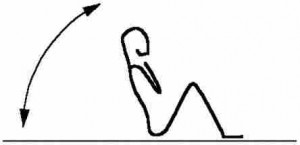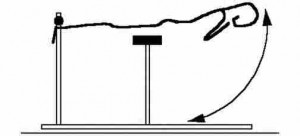by Thomas Kurz
Abdomen crunch. Lie on your back, with feet on the floor so your knees are bent. Alternatively, you can rest your legs on a bench or chair so your thighs form a 90° angle with your trunk. Inhale and then exhale as you raise your shoulders off the ground by tensing your abdomen and bring the bottom front of your rib cage close to your pelvis. The chest leads the movement—not the head. Keep the small of your back (lumbar section) pressed to the floor throughout the whole movement. Inhale as you lower your trunk back to the floor.
Abdomen crunch
When the straight abdomen crunches become too easy, you can do them with a twist. As your raise your shoulders off the ground, raise your right leg and twist your trunk to touch the left elbow to the right knee and then with the next raise twist the other way. Keep your abdomen tense and the small of your back pressed to the floor all this time. When you feel even stronger, take a weight plate and do crunches holding it on the front of your upper chest or take two smaller plates and hold them on either side of your head.
Typically abdomen crunches are done in 1–2 sets of up to 100 reps each. Some athletes (boxers, karateka, wrestlers) do much more than that, depending on the sport. Abdomen exercises can be done every other day, more often than deadlifts, squats, or presses because they are “local”—affect mainly the abdomen. Muscles of the abdomen recover faster than large muscles of the back, thighs, and buttocks, which are strongly affected by such exercises as squats and deadlifts.
Sit-up. Lie on your back, bend your legs, and pull up your feet to where your knees were. You can hook your feet under some immovable object—especially if you do sit-ups with additional weights. Fold your arms on your chest. Inhale and then exhale as you tense your abdomen and raise your trunk from the floor. As with crunches, the chest leads the movement—not the head. During the raise press the small of your back to the floor for as long as possible. After the small of your back leaves the floor straighten up your back so you do not end up in a curled position at the top of the sit-up. Inhale as you lower your trunk back to the initial position. Lowering your trunk, curl it so you press the small of your back into the floor.
Do sit-ups at a moderate speed, with a stop at the bottom and the top positions. If you do sit-ups fast, without a stop (ballistically), you can strain your abdominal muscles or get an abrasion between their layers.
Sit-up
Back extension on the floor. Lie on your stomach with arms at your sides. Inhale and exhale as you smoothly raise your trunk. The top of the upper back leads the movement—not the head.
Back extension on the floor
To make this exercise more difficult, extend your arms as you raise your trunk.
Back extension on the bench. Hang face down over the edge of the bench and hook up your legs. Your pelvis should rest on the edge of bench so it can rotate down as you lower your trunk until it forms a 90° angle at the hip. Experiment to find how far from the edge of the bench the top of your pelvis should be so you feel your lower back muscles work most. Usually you will want the top of your pubic bone to be on the edge of the bench. The further your pelvis hangs over the edge the less your spine flexes forward and the less chance there is for spraining ligaments along the back of the spine. The importance of this grows as you increase the weights you hold in your hands in this exercise. Relax and let your back stretch a little at lowest (initial) position before moving up. Make sure that you raise your trunk by moving your pelvis—in other words, that the movement occurs mainly in your hip joints. Again, the top of the upper back leads the movement—not the head. Exhale as you raise your trunk. Raise the trunk until it is in-line with your legs. Do not raise your trunk any higher to avoid back pain. Inhale as you lower your trunk. Perform the movements at a slow pace to avoid back problems. Initially you can put your hands behind your neck or cross them on your chest, but eventually you will hold a weight plate on your chest or a pair of dumbbells close to your shoulders.
Back extension on the bench
Before attempting strenuous hip flexor and adductor exercises, you should be able to lift (ten or more times) additional weight greater than 1/3 of your body weight. If you cannot do this and attempt hip flexor exercises such as V-sits or hanging leg raises, and adductor exercises such as adductor flys, you will risk injury (sudden or gradual) to the lumbar spine. As the weights used in hip flexor and adductor exercises increase so should the loads strengthening your lower back.
Remember: Back injuries are a result of insufficient strength of the moving and stabilizing muscles, neurological deficiencies, structural problems, and poor lifting or exercise technique.
Training Tip of the Article
- In the long-term training program first strengthen the core of the body and the stabilizing muscles (such as those of abdomen and lower back) to build the foundation for developing power of kicks and punches.
- In a single workout work on power of kicks and punches first, and on the strength of the stabilizing muscles (muscles of the lower back and abdomen) last.
This article is based on the book Science of Sports Training: How to Plan and Control Training for Peak Performance and the video Secrets of Stretching. Get the book and the video now and have all of the info—not just the crumbs! Order now!
If you have any questions on training you can post them at Stadion’s Sports and Martial Arts Training Discussion Forum







Pingback: Advanced Strength Exercises for Lower Back–Your Best Insurance against Back Pain | Tom Kurz's Weblog